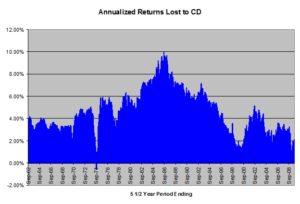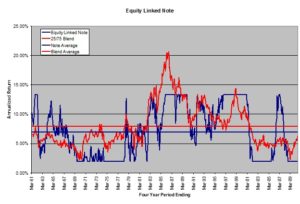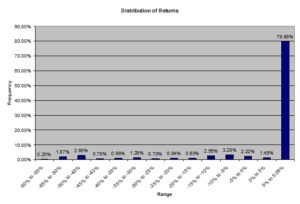Many comparisons of vehicles with differing tax treatments are faulty because they don’t start at the beginning and go all the way to the end. To perform a proper analysis, it is important to start with “Pat earns a dollar” and go all the way to “Pat spends the proceeds.” If the comparison starts with “Pat puts $X in the accounts,” or stops with “the account values are $X,” the conclusions are likely to be erroneous.
Here is a quick mathematical comparison of a Roth vs. a traditional (deductible) IRA.
Assume a 25% marginal ordinary income rate and a 15% capital gains that remains constant.
Scenario 1:
- You earn $1,000.
- You pay $250 in income taxes on it.
- You put the remaining $750 in a Roth.
- The investment grows until it doubles to $1,500.
- You take it out and get to spend $1,500.
Scenario 2:
- You earn $1,000.
- You put it in a deductible IRA (no taxes because it is tax deductible).
- It also doubles and thus becomes $2,000.
- You take it out and pay 25% ($500) in taxes.
- You get to spend $1,500.
As you can see, there is no difference between the two vehicles under those assumptions. Here are the confounding factors:
- If the marginal tax bracket is lower in retirement, it will favor a deductible option; if it is higher, it will favor the Roth option.
- The analysis above assumed that you did not max out the IRA. If you contribute the maximum, it will favor the Roth. Because the Roth takes after-tax funds, and the limits are the same, you can essentially get more earnings into a Roth. An example may clarify this:
Using the same assumptions as above, assume you are going to save pre-tax wages of $8,000 while the maximum contribution level is $6,000 (this doesn’t match current limits of $5,500 or $6,500 if 50 or older, but makes the calculations simple to follow).
Scenario 1:
- You earn $8,000.
- You pay taxes on it ($2,000 in the 25% bracket).
- You place the remaining $6,000 in a Roth.
- It doubles to $12,000.
- You withdraw the funds and get to spend $12,000.
Scenario 2 – IRA Portion:
- You earn $8,000 and put $6,000 in a deductible IRA, (no taxes on that portion).
- The $6,000 in the IRA doubles to $12,000.
- You withdraw the funds paying $3,000 in taxes.
- You get to spend $9,000.
Scenario 2 – Remaining Portion:
- You pay $500 in taxes on the other $2,000 (of the original $8,000).
- You invest the remaining $1,500 in your taxable account.
- It doubles, but has some drag due to taxes (see below).
- At withdrawal, the after-tax amount available to spend is less than $2,775.
(The $1,500 in the taxable account will do less than double because of taxes on dividends, interest, and turnover; but even if we assume it did the full double, it would become $3,000 with a basis of $1,500. At a 15% capital gain rate, the taxes would be $225. So, even with a perfectly tax-efficient investment, you would have only $2,775.)
Adding the $2,775 to the $9,000 proceeds from the IRA is $11,775 which is less than the $12,000 from the Roth. In reality, the difference would be somewhat greater. (Note: If you use very efficient investments like an index fund or ETF that has little turnover and small distributions and hold it till death, it receives a step-up in basis to your heirs, and the overall effect is similar to a Roth. The higher the turnover and distributions, the more inefficient it becomes.)
- Some people with access to a qualified plan may still be able to do a Roth even though their earnings are too high to deduct contributions to a traditional IRA.
- The traditional IRA may be a little better if you are concerned about your children squandering their inheritance. Psychologically, having to pay taxes on discretionary withdrawals may be just the thing to restrain them from taking more than the RMD (Required Minimum Distribution) each year.
- A major assumption is the tax rate in the future. This depends not only on your financial situation but also on tax policy at that time. There has been a long-term trend toward lower marginal rates on a broader tax base. While it seems likely that will reverse at least slightly in the short run, due to modern understanding of the Laffer Curve, rates will probably not rise to the levels many fear. (For a tutorial, see http://www.youtube.com/watch?v=fIqyCpCPrvU.) In addition, the deduction for a traditional IRA happens now, while the Roth is merely a future promise. I am skeptical of government promises, and while it may seem inconceivable that Roth proceeds will incur taxes, at one point it was also inconceivable that Social Security benefits would someday be taxed.
- Despite the preceding paragraph, given future uncertainty, a traditional IRA should probably be the default choice. If you achieve more financial success and are thus in a higher tax bracket, using a Roth will have been preferable. In less rosy scenarios, the traditional IRA would be superior because the tax bracket upon withdrawal is modest. Optimizing the good scenarios isn’t as important as mitigating the less favorable futures, thus favoring the traditional IRA.
- If you desire to leave funds to charity upon death, a traditional IRA will give a tax deduction now for that future contribution. In other words, a tax deduction is received for putting funds into the traditional IRA. A charity may be named as beneficiary (or contingent beneficiary) thus essentially receiving a tax deduction for that future bequest. Not so with the Roth IRA. Conversely, since charitable deductions that are limited by adjusted gross income (AGI) may only be carried forward for five years or until death, whichever occurs first, doing a conversion to create taxable income and thus avoid losing the deduction may be prudent.
- If you have a taxable estate, a Roth is more advantageous since the income taxes paid upfront will no longer be in the estate, though there is an offsetting deduction to heirs upon recognition of the IRD so this issue is smaller than many assume. This factor is more important to the extent that heirs will stretch out their distribution and/or have state or local estate taxes since there is no offsetting deduction in those cases.
To recap, when both a deductible IRA and Roth IRA are available, Roth IRAs are superior when:
- Tax rates will increase for you in the future (either because of your personal situation or because tax rates in general change).
- You are trying to save more than the limits (or have other taxable investments to pay the taxes).
- You have a taxable estate.
- You do not want to be forced to take RMDs after age 70½.
- You trust the tax-free treatment of Roth IRAs will continue in the future.
- You will not leave the funds to charity.
- You will leave a portion to heirs who are in a higher income tax bracket.
Traditional IRAs are superior when:
- Tax rates will decrease for you in the future (either because of your personal situation or tax rates in general change).
- You are not trying to save more than the limits (and don’t have other taxable investments available to pay the taxes).
- You don’t have estate tax issues.
- You will need to withdraw funds to live on in retirement anyway.
- You don’t trust the Congress not to change the tax treatment of Roth IRAs in the future.
- You will leave the funds to charity.
- You will leave a portion to heirs who are in a lower income tax bracket.
You and your advisor will have to weigh the relative importance of these factors to decide which vehicle is right for you.
Roth conversions may be analyzed in exactly the same manner as above, and will frequently be advisable to the extent the taxes on conversion can be paid out of funds that are not currently tax advantaged, and the conversion will not place you in a higher income tax bracket. It may be advisable to perform “opportunistic conversions” by converting the maximum amount each year that will not cause migration into a higher marginal income tax bracket.
Finally, a non-deductible IRA is inferior to both the deductible and the Roth unless you intend to convert it to a Roth in the future. It should be compared to a taxable account where, given a very long time horizon or very tax-inefficient investments, the IRA has advantages. However, because of the lack of flexibility (early withdrawal penalties), more difficulty harvesting losses, ordinary income rather than capital gains tax treatment, and loss of the step-up in basis on death, I would generally choose a taxable account over a non-deductible IRA unless there are significant tax-inefficient holdings in the portfolio that exceed the amount of tax-advantaged space. In other words, your high returning, ordinary income property is being held in your taxable account because there isn’t room in the IRA or Roth.
It may be advisable to initially convert larger amounts than you actually intend to convert in order to exploit the opportunity to recharacterize the “losers.” For example, you have $100,000 in an IRA and want to convert $20,000 of it to a Roth. Converting all $100,000 in January into separate Roth IRAs for each asset class may be advisable. Suppose, in this case, $20,000 is placed in each of five Roth IRAs, each invested in a different type of investment. Prior to October 15th of the following year (the tax due date with extensions) the four Roth IRAs that appreciated the least can be recharacterized back to an IRA leaving only the “winner” converted.


